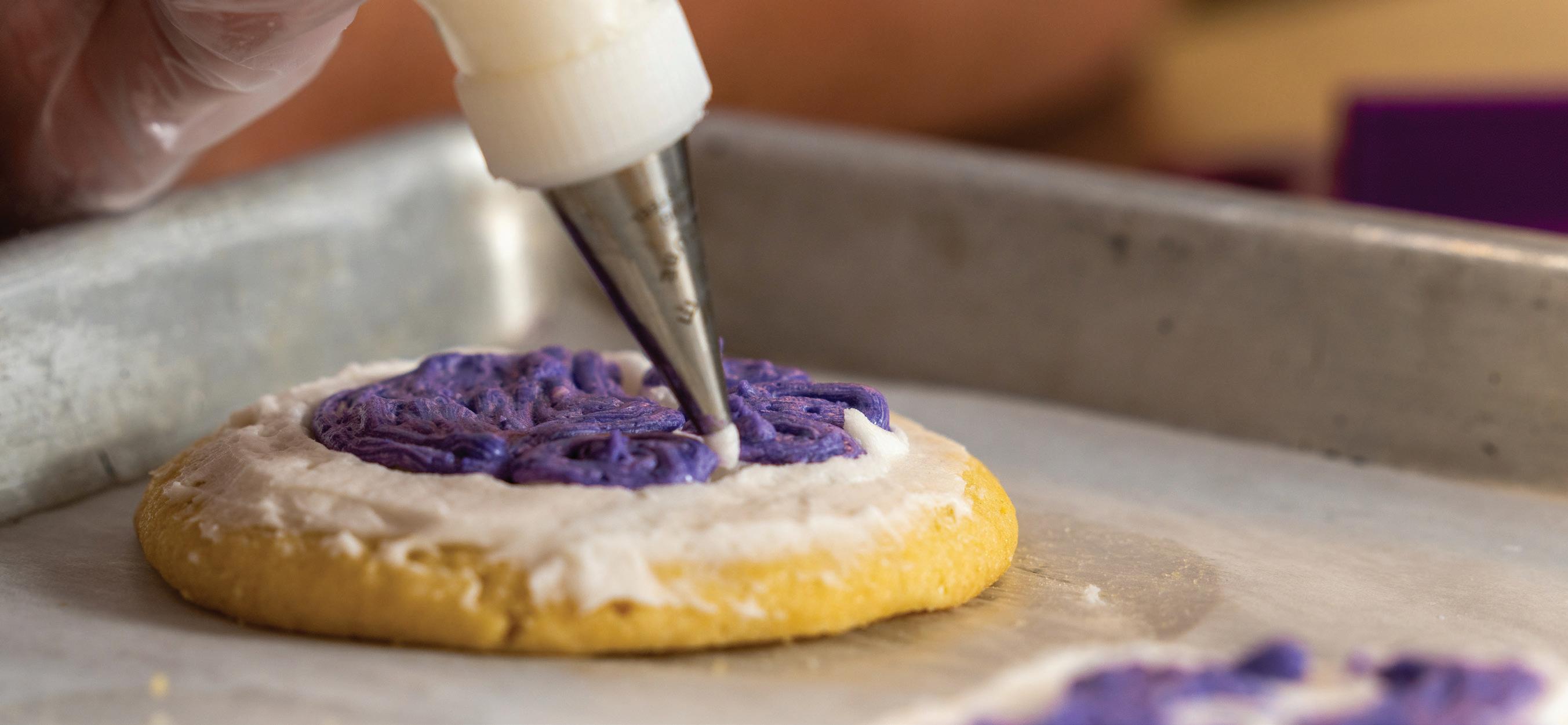
7 minute read
PROTECTING AGRICULTURE
The National Bio and Agro-Defense Facility, or NBAF, which will be owned and operated by the USDA, is adjacent to K-State’s Biosecurity Research Institute.
Like a good neighbor, this next-generation federal facility will strengthen Manhattan’s agricultural legacy
Advertisement
BY STEPHANIE JACQUES ’05, NBAF PUBLIC AFFAIRS SPECIALIST PHOTOS COURTESY OF NBAF
Behind tall secure fences, with impressively thick steel doors and multiple layers of reinforced concrete, is Kansas State University’s newest neighbor: The National Bio and Agro-Defense Facility, or NBAF.
On more than 48 acres, NBAF sits adjacent to the university’s Biosecurity Research Institute and the College of Veterinary Medicine. The federal facility will add a new high-tech chapter in Manhattan’s history book and offer a variety of opportunities to those interested in protecting agriculture.
Through this world-class science facility for large animal agricultural research, diagnostics and training, NBAF leadership has a vision of a safer and more resilient America. The facility’s mission is to protect the nation’s food supply, economy and public health from transboundary, emerging and zoonotic animal diseases — in line with many K-State priorities.
Transboundary animal diseases, or foreign animal diseases, are those that could enter the U.S. from another country. Emerging diseases are ones that are new or not well known and zoonotic diseases normally affect animals, but can transfer to people.
Protecting livestock and agricultural interests from these diseases also protects the economy. Agriculture, food and related industries contribute more than $1.1 trillion to the U.S. economy, according to the U.S. Department of Agriculture’s Economic Research Service. In addition, 11% of jobs — about 22 million — have some ties to agriculture.
The USDA’s Agricultural Research Service, or ARS, and Animal and Plant Health Inspection Service, or APHIS, will share responsibility for the $1.25 billion facility after the U.S. Department of Homeland Security, or DHS, is finished building it. When the USDA-owned facility is fully operational, about 400 federal employees will work to anticipate, prevent and mitigate risks to animal agriculture.
USDA HAS PROTECTING AGRICULTURE DOWN TO A SCIENCE
Currently, the USDA’s foreign animal disease research, training and diagnostics includes African swine fever, classical swine fever and foot-and-

mouth disease. The latter has not been seen in the U.S. since 1929.
USDA and DHS scientists help keep it that way by working in biosafety level-2 and -3 laboratories at the 1950s-era Plum Island Animal Disease Center, or PIADC, in New York. Though there have been many successes, the aging lab has limited capability to address the growing need for diagnostics and countermeasures for other highconsequence and emerging zoonotic diseases.
“Although PIADC continues to provide critical cutting-edge research and diagnostic services to keep U.S. agriculture safe, its mission requires the more modern and state-of-the-art facility that NBAF will provide,” said Dr. Luis Rodriguez, USDA Foreign Animal Disease Research Unit leader at PIADC.
NBAF will be a safe place to expand the animal disease research, diagnostics, training and countermeasure developments — like vaccines — for more diseases including those that are emerging and zoonotic.
“According to the World Health Organization, more than 70% of emerging diseases that have affected humans in the last 10 years have an animal component,” said NBAF coordinator Dr. Ken Burton ’77, ’81. “To understand some of these zoonotic diseases in large livestock, they must be studied in the highest level of laboratory containment: biosafety level-4, or BSL-4, which is not available in the U.S. today. Currently, we must rely on other countries’ facilities to conduct this work.”
TOP: On more than 48 acres, NBAF will provide USDA and DHS scientists with ample space to tackle highconsequence animal pathogens. BOTTOM: NBAF’s modern design melds high-containment structural integrity with eye-pleasing features to attract the best scientists and technicians to conduct critical science.

NBAF will be the first facility in the U.S. with BSL-4 laboratories capable of housing livestock. It also will have BSL-2 and -3 laboratories. Yet, the greatest attribute of the facility is the people. To strengthen NBAF’s mission, many PIADC scientists and technical experts have already moved or committed to move to the new facility to share their experiences.
“I am privileged to work with these devoted heroes who silently protect American agriculture and livelihood,” said Dr. Chuck Dodd ’04, ’10, PIADC transition program manager. “Although sad to leave their successful legacy at Plum Island, many are excited to serve at NBAF and become a part of the Manhattan community.”
NBAF’S HOME IS WHERE THE HEARTLAND IS
Manhattan is a prime location for the USDA to connect with those they aim to protect: agricultural producers. Literally cemented in the middle of cattle country, NBAF is being built with the best technology, severe weather readiness and structural integrity to safely establish the science programs in the Midwest.
“In an earlier review of the program, The National Academies of Science noted that the NBAF design meets or exceeds modern biocontainment design principles and standards,” said Tim Barr ’85, NBAF program manager for DHS. “The laboratory’s critical systems include redundant safety and biocontainment features. Specifically, in the case of a tornado, the facility’s biocontainment areas are designed to lock down like an airtight vault.”
Selecting NBAF’s location was an extensive three-year process. After visiting 17 possible sites, DHS and USDA subject matter experts selected five finalists. Manhattan was officially selected in January 2009, after many public meetings. K-State’s Dr. Marty Vanier ’79, ’81, director of the National Agricultural Biosecurity Center, has been an NBAF advocate since the beginning.
“Manhattan was selected based on federal criteria, which included proximity to and capability of livestock research; available workforce; capability for land acquisition and construction operations; and public support,” Vanier said. “A threat and risk assessment and environmental assessment also were performed and included in the final selection criteria.”
NBAF’s Little Apple location is advantageous for developing potential partnerships to expedite the development of vaccines and diagnostic tests.
“There are the obvious benefits of additional jobs for the Manhattan community, but there also is the added benefit of collaboration between NBAF scientists and K-State scientists and students to advance the study of livestock pathogens of concern,” Vanier said.
Manhattan is on the western edge of the Animal Health Corridor, which has the highest concentration of animal health companies in the nation. Uniting academic, industry and federal researchers creates diverse partnerships that will help tackle these high-consequence animal and zoonotic diseases.
“NBAF is actively engaged in exploring opportunities to collaborate and partner with the many assets available throughout the Animal Health Corridor, Manhattan community and Kansas State University,” Burton said. “As we transition our science mission and scientists from PIADC to NBAF, we anticipate our current relationship with K-State’s College of Veterinary Medicine and Biosecurity Research Institute will continue and potentially expand.”
K-STATERS FIGHTING, EVER FIGHTING FOR A DISEASE-FREE VICTORY
K-State faculty are not the only Wildcats establishing working relationships with federal scientists. Several K-State students have been among those nationally selected to participate in USDA’s competitive NBAF workforce development programs.
Eight K-State students have been a part of APHIS’ NBAF Scientist Training Program, or NSTP. These students receive research and educational funding and are guaranteed employment at PIADC or NBAF after the program.
“It’s been an amazing experience,” K-State graduate student and NSTP participant Jerusha Matthews ’17 said. “Being at PIADC has given me tons of training opportunities and a variety of networking opportunities I don’t think I would have had.”
APHIS also hosts a two-month summer program in collaboration with K-State called the NBAF Laboratorian Training Program. Undergraduate students and recent graduates gain skills needed to serve as lab technicians in facilities like NBAF.
In addition, eight K-State students have been a part of ARS’ NBAF Workforce Development. Participants are trained in biodefense research and are given funding toward a degree in scientific disciplines needed at NBAF.
USDA, K-State, the Manhattan community and state have been working for nearly two decades to ensure this area is recognized as a leader in agro- and biological sciences. NBAF and its collaborative possibilities will attract the best and the brightest minds to continue the legacy of protecting agriculture and the food supply.
K-State student Em Knobbe practices highcontainment laboratory techniques she learned through the USDA Animal and Plant Health Inspection Service 2020 NBAF Laboratorian Training Program.










